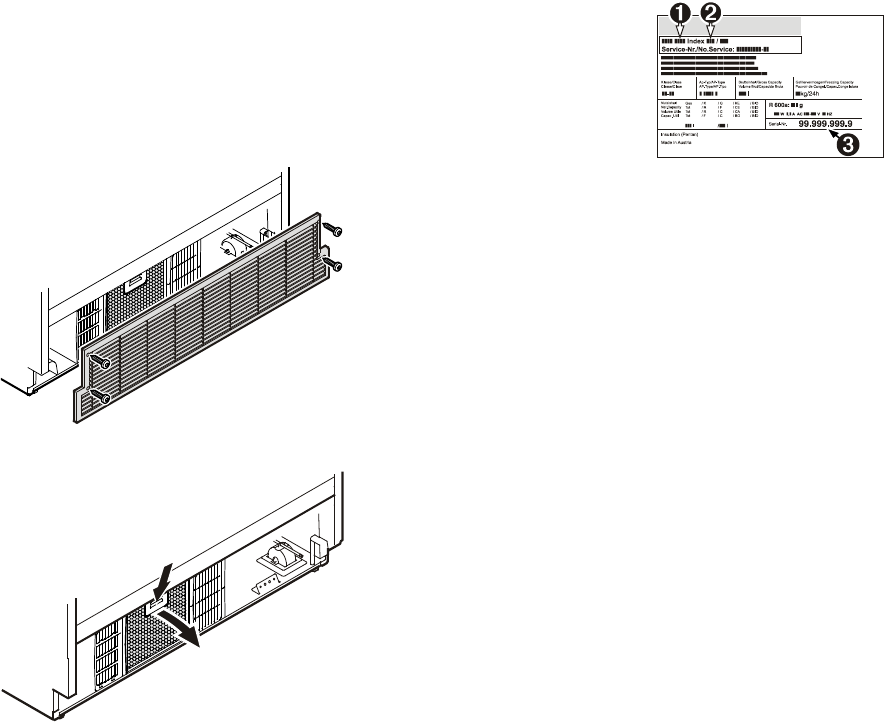
Malfunctions
Your appliance is designed and manufactured for a lengthy, reliable
operating life with no malfunctions. If a malfunction nonetheless
occurs during operation, check whether it is due to an operating
error. Please note that even during the warranty period the result-
ant servicing costs in this case will have to be borne by the owner.
You may be able to rectify the following faults by checking
the possible causes yourself:
Appliance does not function:
– Is the appliance switched on?
– Is the plug correctly tted in the mains socket?
– Is the fuse intact?
Loud running noise:
– Is the appliance set up rmly on the oor?
– Does the appliance cause nearby items of furniture or objects to
vibrate? Please note that noises caused by the refrigerant circuit
cannot be avoided.
The temperature is not low enough:
– Is the temperature setting correct (see "Setting the temperature")?
– Have excessive amounts of fresh food been placed in the appli-
ance?
– Does the separately installed thermometer show the correct read-
ing?
– Is the ventilation system working properly?
– Is the appliance set up too close to a heat source?
If none of the above causes apply
and you cannot rectify the fault
yourself, contact the nearest cus-
tomer service department stating
the type designation ➊, index ➋ and
appliance number ➌ as indicated
on the type plate. The type plate is
located inside the appliance on the
left-hand side (refrigerator).
Shutting your appliance down
If your appliance is to be shut down for any length of time, switch
it off and disconnect the plug or switch off or unscrew the fuse.
Clean the appliance and leave the door open in order to prevent
unpleasant smells.
The appliance complies with the relevant safety regulations and
EC Directives 2004/108/EC and 2006/95/EC.
All types and models are subject to continuous improvement and
the manufacturer therefore reserves the right to make modifica-
tions to the shape, equipment and technology.
Cleaning
Before cleaning always switch off the appliance. Pull out the
mains plug or switch off or unscrew the fuse.
Clean the inside, equipment and outer walls with lukewarm water
and a little detergent. Do not use abrasive or acid cleaners or
chemical solvents.
Do not use steam cleaners because of the risk of injury and
damage.
• Ensure that no cleaning water penetrates into the electrical com-
ponents or ventilation grille.
• Dry all parts well with a cloth.
• Do not damage or remove the type plate on the inside of the ap-
pliance. It is very important for servicing purposes.
• Use a commercially available stainless-steel cleaning agent for
stainless-steel appliances.
- In order to achieve best possible protection, apply a stainless-steel
care agent uniformly in grinding direction after cleaning. Points
which are darker at the start and a more intensive coloration of
the stainless-steel surface are normal.
- Do not use abrasive sponges or scourers, do not use concentrated
cleaning agents and never use cleaning agents containing sand,
chloride or acid or chemical solvents, as these would damage the
surfaces and could cause corrosion.
GB
4. Push down the button on the filter, tilt the filter forwards
and remove.
The dust filter can be washed in a dish-
washer or by hand using water and
detergent.
Cleaning the dust filter
The dust filter in the appliance plinth must be cleaned at least
once a year.
1. Disconnect the appliance from the mains.
2. Pull the bottom freezer drawer right out.
3. Unscrew the ventilation grille.
5. Dry the filter and then, in reverse order, replace it.
6. Re-attach the ventilation grille.
21













